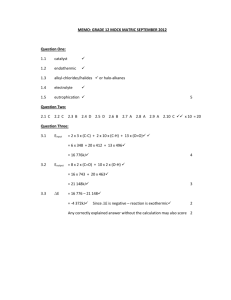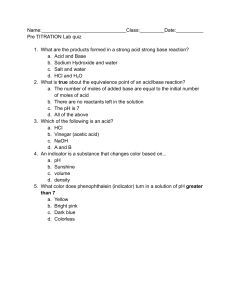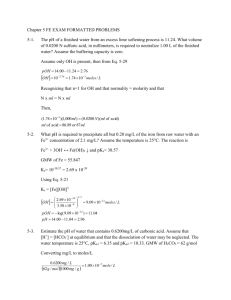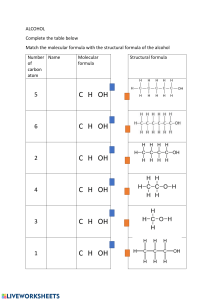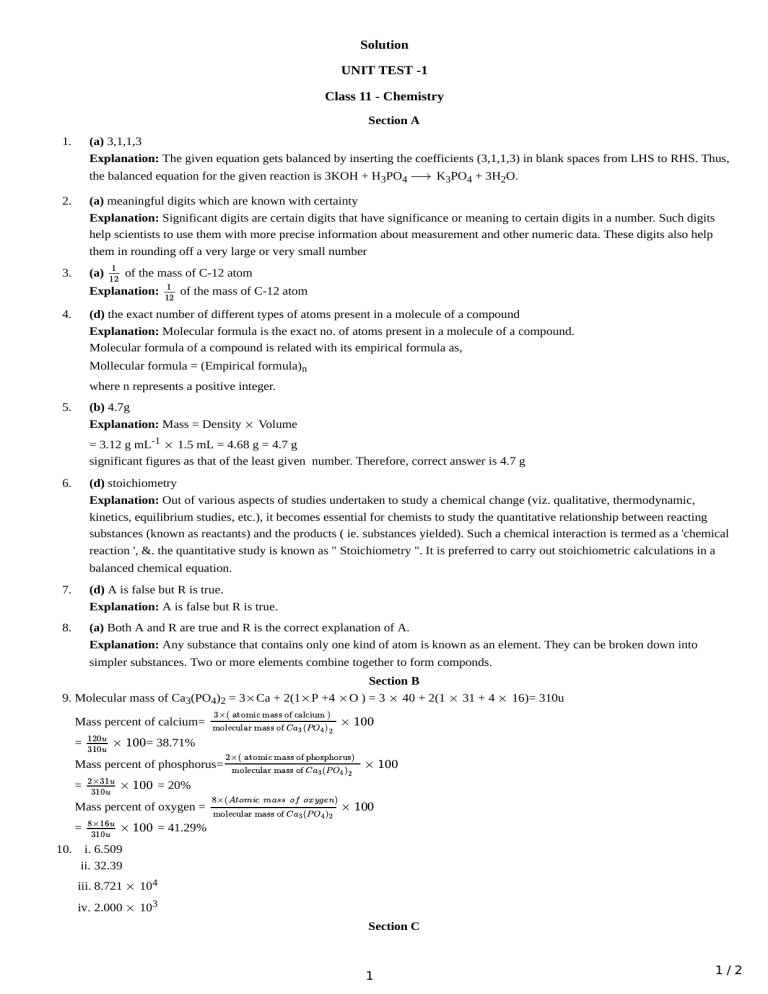
Solution UNIT TEST -1 Class 11 - Chemistry Section A 1. (a) 3,1,1,3 Explanation: The given equation gets balanced by inserting the coefficients (3,1,1,3) in blank spaces from LHS to RHS. Thus, the balanced equation for the given reaction is 3KOH + H3PO4 ⟶ K3PO4 + 3H2O. 2. (a) meaningful digits which are known with certainty Explanation: Significant digits are certain digits that have significance or meaning to certain digits in a number. Such digits help scientists to use them with more precise information about measurement and other numeric data. These digits also help them in rounding off a very large or very small number 3. (a) of the mass of C-12 atom 1 12 Explanation: 4. 1 12 of the mass of C-12 atom (d) the exact number of different types of atoms present in a molecule of a compound Explanation: Molecular formula is the exact no. of atoms present in a molecule of a compound. Molecular formula of a compound is related with its empirical formula as, Mollecular formula = (Empirical formula)n where n represents a positive integer. 5. (b) 4.7g Explanation: Mass = Density × Volume = 3.12 g mL-1 × 1.5 mL = 4.68 g = 4.7 g significant figures as that of the least given number. Therefore, correct answer is 4.7 g 6. (d) stoichiometry Explanation: Out of various aspects of studies undertaken to study a chemical change (viz. qualitative, thermodynamic, kinetics, equilibrium studies, etc.), it becomes essential for chemists to study the quantitative relationship between reacting substances (known as reactants) and the products ( ie. substances yielded). Such a chemical interaction is termed as a 'chemical reaction ', &. the quantitative study is known as " Stoichiometry ". It is preferred to carry out stoichiometric calculations in a balanced chemical equation. 7. (d) A is false but R is true. Explanation: A is false but R is true. 8. (a) Both A and R are true and R is the correct explanation of A. Explanation: Any substance that contains only one kind of atom is known as an element. They can be broken down into simpler substances. Two or more elements combine together to form componds. Section B 9. Molecular mass of Ca3(PO4)2 = 3× Ca + 2(1× P +4 × O ) = 3 × 40 + 2(1 × 31 + 4 × 16)= 310u Mass percent of calcium= = 120u 310u × 100 3×( atomic mass of calcium ) molecular mass of Ca3 (P O4 ) = 38.71% Mass percent of phosphorus= = 2×31u 310u × 100 = 310u × 100 2×( atomic mass of phosphorus) molecular mass of Ca3 (P O4 ) × 100 2 = 20% Mass percent of oxygen = 8×16u × 100 2 8×(Atomic mass of oxygen) molecular mass of Ca3 (P O4 ) 2 × 100 = 41.29% 10. i. 6.509 ii. 32.39 iii. 8.721 × 104 iv. 2.000 × 103 Section C 1 1/2 11. 2N (g) + O2 (g) → 2N2 O (g) 2 2V 45.4 22.7 =2 1V 22.7 22.7 =1 2V 45.4 =2 22.7 Hence, the ratio between the volume of the reactants and the product in the given question is simple i.e. 2:1:2. It proves the GayLassac's law of gaseous volumes. Gay Lussac’s Law of Gaseous Volumes (Given by Gay Lussac's in 1808) : According to this law, when gases combine or are produced in a chemical reaction they do so in a simple ratio by volume, provided all the gases are at same temperature and pressure. 12. As shown in figure, the masses of H and O which combine with the fixed mass of S, i.e. 32 parts are 2 and 32 i.e. they are in the ratio 2 : 32 or 1 : 16. When H and O combine directly to form H2O, the ratio of their combining , masses are 2:16 or 1 : 8. These ratio are related to each other as 1 16 : 1 8 =1:2 i.e. they are simple multiple of each other. Section D 13. millimoles of HCl = Molarity × Volume (in mL) where Molarity = 0.75 M , Volume = 25 ml We know that millimoles of HCl = millimoles of CaCO3 So, millimoles of CaCO3 = 25 mL × 0.75 M of HCl = 18.75 millimoles = 18.75 × 10-3 moles From the given reaction it is clear that 2 moles of HCl reacts with 1 mole of CaCO3 C aC O3 + 2HC I (aq) → C aC I2 (aq) + C O2 (g) + H2 O(I ) So 18.75 x 10-3 moles of HCl reacts with 18.75×1 2 × 10-3 moles of CaCO3 = 9.375 × 10-3 moles mass of CaCO3 required = molar mass of CaCO3 × moles of CaCO3 mass of CaCO3 = 100 g/mol × 9.375 x 10-3 mol = 0.9375 g 1 2/2
